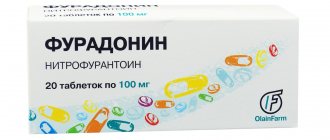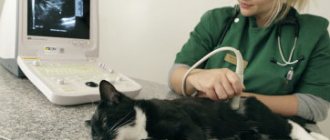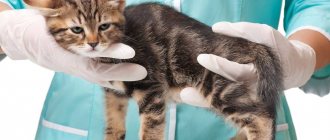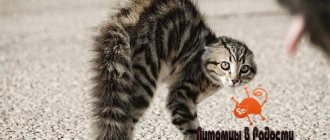A visit to the cat litter box is a real “sacred act.” This is what they do every day. As a rule, the act of urination takes a little time. If you notice that your pet sits on the tray for a long time, and this presumably causes him discomfort, it’s time to consult a veterinarian. After all, this is exactly how urolithiasis can manifest itself. In cats, this is a very unpleasant disease, often leading to severe side effects. In old and young animals it can even be fatal.
Calcium phosphates
Calcium phosphates are a group of related urolites: whitlockite (Ca3(PO4)2), brucite (CaHP04.2H2O), hydroxyapatite (Ca5(PO4)3OH). These compounds are more often found in mixed stones, in combination with oxalates and struvite. The formation is associated with increased concentrations of calcium and phosphates in the urine. The risk of formation increases at alkaline pH.
Risk factor: hypercalcemia. It may be associated with a number of pathologies, for example, primary hyperparathyroidism. Among dietary factors, hypercalcemia, and, as a consequence, the formation of phosphate uroliths, is provoked by vitamin D hypervitaminosis.
Why does urolithiasis occur?
All causes that provoke the formation of urinary stones are divided into external (exogenous) and internal (endogenous).
Exogenous causes:
- Violation of feeding conditions. If cats have poor nutrition or lack of water, their metabolism is disrupted, the concentration of urine increases and its pH changes. Against this background, sand begins to form and urinary stones of various natures begin to form.
- Climate and geochemical situation. Increased ambient temperature increases diuresis, and urine becomes much more concentrated than under normal conditions. If the water that cats are given is saturated with various salts, then the deposition of stones in the urine will not take long to occur.
- Lack of vitamin A. This vitamin has a beneficial effect on the cells that line the mucous membrane of the bladder. With hypovitaminosis A, the condition of the mucous membrane worsens, which provokes urolithiasis.
Endogenous factors:
- Hormonal imbalances, which can disrupt mineral metabolism in the body with the formation of stones.
- Congenital features of the anatomy of the urinary tract.
- Disorders of the gastrointestinal tract, in which the acid-base balance is lost and sand and stones appear in the bladder.
- Infections. Viruses and bacteria, through their vital activity, can provoke the development of the disease.
- Genetic predisposition. It has been proven that ICD can be inherited in cats. More precisely, a predisposition to the disease is inherited, and any unfavorable conditions provoke pathology.
- Obesity and sedentary lifestyle.
- Various genitourinary diseases provoke signs of inflammation in the bladder, and then cystitis is complicated by stones.
Feeding cats with mixed type of urolithiasis
In some cases, cats develop mixed types of uroliths. Quite often, this problem occurs after surgical removal of stones and the transition to a new diet - with insufficient medical supervision, an excessive pH shift and the formation of a new type of stones are possible. Remember that only a veterinarian can prescribe a therapeutic diet for urolithiasis! For cats, the risk of developing the struvite-oxalate type of urolithiasis is quite high; measures for treating these stones are diametrically opposed - acidification of urine in the struvite-oxalate type of urolithiasis and the use of treats for cats leads to the formation of oxalates. For prevention, the most suitable pH level is 6.8 – 6.9. This type of stone requires particularly careful monitoring of treatment, regular urine tests and ultrasound.
In our center you can order a calculation of a home diet or a selection of a therapeutic commercial diet from a veterinary nutritionist.
Important information about ICD
Urolithiasis or urological syndrome develops as a result of metabolic disorders, which is characterized by the deposition of sand and urinary stones in the bladder.
The risk group includes cats and cats:
- age category from two to six years;
- overweight;
- long-haired breeds.
There is an opinion that urolithiasis most often develops in cats that have been sterilized. Actually this is not true. Mature, non-sterile cats that go into heat are at risk of getting sick, but for some reason they don’t get sick during this period. If we talk about males, then indeed castrated cats automatically fall into the risk group, since they are the ones who more often suffer from the disease due to the different structure of the urinary system and a narrower urethra than in females.
Females practically do not suffer from this disease, since their ureter is wider and even if sand forms there, it comes out freely without causing inconvenience to the animal.
It should be noted that the presence of sand or stones in an animal’s bladder is not a sign that it is developing kidney stones. Although this can also happen.
Types of urinary stones
The type of salts deposited in the animal’s bladder affects the formation of stones of one group or another. Most often these are struvite and oxalates. For example, struvites are phosphates and are formed mainly in cats under six years of age. They are distinguished by hardness and friability. Stones appear due to an incorrect or unbalanced diet, leading to alkalization of urine.
Oxalate formations are salts of oxalic acid and are formed in pets after seven years. They are most often found in Burmese, Persian and Himalayan cats. The stones are characterized by sharp edges and friability. They are formed when there is an excess of calcium compounds, leading to acidification of the urine.
Pain, discomfort and inflammation occur when stones or sand pass through the urethra. Therefore, with urolithiasis, the animal’s urine may contain blood, and when urinating, it will experience pain due to damage to the walls of the ureter and inflammation of the bladder.
How to prevent urolithiasis in cats
Prevention of urolithiasis in cats is as follows:
- monitor the diversity of your pet’s diet, and if the need arises, purchase specialized food;
- avoid the development of obesity by controlling the caloric content of food (for this you can contact a specialist);
- encourage regular water consumption by ensuring its availability and freshness;
- keep the animal active, preventing laziness from developing;
- do an ultrasound every six months, especially if there is a predisposition to urolithiasis;
- regularly submit your cat’s urine to the clinic to test for salts;
- undergo a full course of treatment if sand or stones are detected.
Such simple measures will ensure the health of your mustachioed pet for many years. If the cat has already been treated for urolithiasis, then they will help avoid relapse, because it is impossible to completely get rid of this pathology.
Urolithiasis in cats is a fairly common dangerous pathology, often leading to the death of the animal. With early detection of symptoms of the disease and timely adoption of therapeutic measures, one can hope for a favorable outcome. In advanced cases, the animal requires hospitalization and surgical intervention, which does not always result in a positive result. In this regard, every owner of such a pet should know what the signs of urolithiasis in cats are and, if they appear, immediately take appropriate measures.
Natural nutrition
An incorrectly selected diet is one of the common causes of the appearance or recurrence of urolithiasis. The ideal option is to develop a diet for cats with urolithiasis with a specialist in this field.
When eating natural foods, vitamins A and B are additionally prescribed. For oxalate urolithiasis, carrots, boiled eggs, and white beets are recommended for pets, and for struvite urolithiasis, cheese, cottage cheese, boiled meat and rice. Food must be freshly prepared.
You should exclude pork, chicken, fish, sausages, canned food and caviar from your furry friend’s diet. Dishes should be dietary, that is, non-acidic, low-fat, non-spicy and unsweetened. They should not contain excessive amounts of protein.
Diagnostics
Sometimes owners, to confirm or refute their guesses about urolithiasis in a cat, use the “grandmother’s method” - they place a transparent jar of cat urine on the windowsill for an hour. This analysis for ICD is not reliable! You may see sediment, but it is due to normal, natural reactions and not as evidence of illness in the cat.
In any case, you need to consult a veterinarian to diagnose urolithiasis.
What the specialist operates on:
- palpation (less often);
- urine test;
- Ultrasound;
- regular x-ray;
- contrast x-ray;
- surgical intervention.
Do not confuse urolithiasis with cystitis in cats.
Video
Prevention
To prevent the formation of uroliths, the following actions are recommended:
- Replace low-quality drinking water with bottled or filtered water.
- Monitor urine pH using special tests.
- Keep the tray clean. A cat would rather wait until a walk than use a dirty toilet.
- Prevent obesity. Prepared high quality feed is used. Active games are played regularly. Avoid the consumption of treats and human food.
- Avoid hypothermia and overheating.
- Undergo regular diagnostic examinations twice a year.
If a cat develops uroliths, it will have to change its lifestyle. A responsible fellinologist is able to provide a sick pet with satisfactory health and a long life.
We invite you to join our Zen channel and group on VKontakte or Odnoklassniki, where new articles for pet owners are published.
Similar articles:
- If your cat has food allergies
- Ringworm Caution: What Pet Owners Need to Know
- Why are cats overweight?
How to determine if a cat is sick
If there are stones in the bladder that do not block the lumen of the ureter, and sand, the disease can be asymptomatic for a long time. When stones have already formed, the symptoms of urolithiasis in cats appear quite clearly. The intensity of the manifestation of symptoms of urolithiasis in cats can be divided into 3 degrees - the first (initial or mild) signs, severe and critical symptoms.
- Initial symptoms: the cat goes to the toilet very often and for a long time, and may begin to do this in completely inappropriate places (its litter box simply begins to be associated with pain and discomfort);
- there is a posture of tension when urinating;
- licks himself under his tail for a long time;
- urine takes on a slightly pinkish tint;
- sometimes when urinating, a cat may meow, and precisely at the end of the process;
- the animal looks worried.
- the urge to urinate becomes more frequent and always painful;
- the cat generally stops going to the toilet for a little while (there is an urge and it is clearly painful, attempts are made to urinate, but urine is not released);
In case of critical symptoms, time runs out against the clock in order to save the animal’s life by delivering it to a specialist.
Drugs for the treatment of urolithiasis in cats
Of course, veterinarians use the main protocols for the treatment of urolithiasis in cats, but they are sure that each of the protocols contains the following medications:
- Stop cystitis
Bio-suspension reduces crystallization due to its composition: lingonberry leaves, nettles, barberry, licorice root. By the way, this drug can also serve as a pain reliever.
- Uro-ursi
A medicine that is often prescribed concomitantly with antibiotic therapy, because it contains benzoic acid, which enhances the effect of antibiotics.
- Urotropin
The diuretic effect of "Urotropin" and its ability to increase the permeability of cell membranes accelerates the process of eliminating toxins.
- Cystokur forte
The food additive reduces the acidity of the body and helps the cat recover faster after treatment.
- Furinaid
Gel-like drops form a protective film on the bladder mucosa.
- Ipakitina
The components of this drug bind phosphates that the cat receives from food and reduces their availability.
- Cantaren
The homeopathic remedy works as an anti-inflammatory, antispasmodic, and diuretic.
- Kotervin
The aqueous extract of medicinal plants has salt-removing and stone-dissolving effects.
- Nephrocat
Contains natural bee jelly and biologically active substances.
- Renal Advance
The drug shows itself well in the later stages of the development of urolithiasis in cats, while it improves the functioning of the digestive system.
- HIMALAYA Cyston
The Indian remedy copes well with cystitis and has proven to work well in combination with antibiotics.
- Dexamethasone
This drug is often prescribed when there is persistent dysuria.
- Nitroxoline
This synthetic agent has an antimicrobial effect.
- Actovegin
Injections of this powerful drug activate cellular metabolism, which means metabolic processes are enhanced.
Diet
In combination with treatment, the specialist prescribes a special diet for the animal. It is selected depending on the type of disorder in salt metabolism that causes urolithiasis. The diet in cats helps restore the correct metabolic process and also maintains homeostasis. The choice of dietary nutrition depends on the type of disorder in salt metabolism:
- oxalt - the diet is aimed at maintaining the pH in the urine from 6.8 to 7.2 and dissolving uroliths;
- struvite – the chosen diet prevents the formation of struvite, restores the normal density, volume and pH level of urine, for this purpose it reduces the consumption of minerals, in particular magnesium (no more than 20 mg per 100 kcal).
Tripelphosphates (struvite) in cat urine: how to treat
The cause of the disease is determined during a clinical examination, taking into account the collection of anamnesis, as well as urine examination. The sediment contains characteristic crystals of tripelphosphate (struvite). Determine the chemical composition and pH of urine. Ultrasound and radiography are used to determine the localization of stones, their shape and location.
After determining the cause of the disease, the veterinarian develops a treatment strategy.
It is developing in the following directions:
- Restoring the outflow of urine. For partial blockage, conservative treatment and diet therapy are used. In case of complete blockage, surgical methods are used.
- Fighting intoxication, pain and dehydration.
- Preventing exacerbations.
Treatment with drugs
To treat urolithiasis, veterinary drugs and those medications prescribed by the doctor are used.
The following groups of medications are used:
- analgesics;
- antispasmodics;
- anti-inflammatory drugs;
- antimicrobial agents.
- stone-dissolving medications.
The effectiveness of treatment is determined by regular examinations of the cat at intervals determined by the veterinarian.
Folk remedies
The use of folk remedies is contraindicated and causes the death of the pet. During the period of remission, the veterinarian may prescribe the use of pharmaceutical herbal medicines, which use products proven in traditional medicine.
Surgery
A catheter is used to restore the flow of urine. The operation is performed under general anesthesia; a very thin tube is inserted into the urethra, the obstruction is destroyed and urine is released.
If radiography shows the presence of stones in the bladder and ureters, retrograde lavage is performed with the introduction of a medicinal solution into the cavity of the urinary reservoir through a puncture through the abdominal wall.
Be sure to read:
Kidney stones in a cat: causes, symptoms, what to do, medication and alternative treatment
If the above methods do not lead to the desired result, abdominal surgery is performed: stones are removed from the bladder or a kidney is removed. In special cases, a urethrotomy is performed - an artificial opening is created for the release of urine.
Diet therapy
Owners of sick cats will have to forget about natural food and treating their pet with treats. The veterinarian prescribes medicated foods that contain acidifiers.
The following medicinal foods are in demand:
- Royal Canin Urinary S/O High Dilution, which is designed to accelerate the destruction of tripelphosphates and prevent urolithiasis.
- Hill's s/d to dissolve struvite stones in cats and prevent the formation of new ones.
Dietary foods are highly energy-rich due to fats. They contain a reduced amount of carbohydrates, as well as materials for the formation of uroliths - calcium, phosphorus, magnesium. Vitamins, microelements, antioxidants, and table salt are added to the feed mixture.
Veterinary nutrition is prescribed for 2-3 months. After completion of treatment and follow-up examination, the veterinarian recommends changing food or leaving the same food for lifelong use.
Dietary food is prescribed when struvite uroliths are detected in the urine. During treatment, urine tests must be performed regularly. Therapy is continued for 2-3 months, after which it is transferred to a different diet or left the same for life.
What to feed a cat with urolithiasis
Only with proper nutrition can a cat diagnosed with ICD live painlessly for several more years. Since some pets prefer exclusively dry food, while others prefer homemade food, approaches to diet will vary.
Dry food for a cat with ICD: which one to choose
Most dry food is completely unsuitable for feeding a cat with urolithiasis - they contain too many mineral salts. But there are also special mixtures that can be selected depending on the type of urinary stones, for example:
- Oxalates – Royal Cannine Urinary S/O LP34, Hill's PD Feline K/D;
- Struvite – Purina Pro Plan Veterinary Diets UR, Hill's Prescription Diet C/D.
You only need to buy food that belongs to the premium and super-premium class.
How to feed your cat homemade food
Home feeding of a cat with urolithiasis also depends on the type of stones. Since the high acidity of urine is caused by calcium, you need to limit your pet to eggs and milk (and their derivatives). Vegetables rich in this element should also be excluded from the cat's diet. In addition, with oxalates, it is extremely undesirable to give your pet offal, since they contain a large amount of oxalic acid.
Monotony in food should be avoided. The cat's menu should be based on meat dishes, while adding industrial food of any kind to the food is prohibited.
It is important to provide the animal with free access to water. Since cats drink little, you need to try to teach your pet to regularly visit the watering hole. The water bowl should not be located next to the food bowl so that the cat does not turn his attention to the food.
Emergency help
Hyperkalemia and metabolic acidosis are another reason why animals with urethral stone obstruction should receive emergency treatment from an experienced veterinarian. If possible, it is advisable to perform an ECG and measure the level of potassium in the plasma immediately after the animal arrives at the clinic. But more often, the pet needs immediate first aid: a catheter is used to drain the accumulated urine , and intoxication is alleviated by administering intravenous detoxification solutions.
Prevention of urolithiasis in cats
Prevention of this disease in cats consists of observing the following rules:
- feed only high-quality feed;
- use purified water for drinking - it is not recommended to use tap water, as it contains an excessive amount of salts;
- provide your pet with round-the-clock access to water;
- do not overfeed the cat, especially for castrates who have reduced motor activity;
- monitor the amount of proteins in natural food - there should not be too much or too little of them in the cat’s diet;
- play with your pet as often as possible and take him for a walk outside;
- do not mix ready-made food and natural food;
- provide your pet with a variety of food;
- monitor the air temperature in the house - it should not be too high;
- after castration or sterilization, transfer your pet to special food;
- regularly, at least once a year, carry out preventive veterinary examinations;
- When pathologies are identified, begin their treatment immediately.
Mechanism of stone formation
So, instead of urine, a supersaturated solution was formed. Physics tells us what will happen next - salts and other substances contained in it begin to settle in the cavity of the bladder and other organs of the genitourinary system. If the animal is already suffering from some kind of bacterial infection of the genitourinary system, the process goes even faster. As we already wrote above, in this case, the organ cavity already has a so-called “organic matrix”.
Salt crystals settle on it, and further petrification (petrification) occurs. If at the same time the nutrition, physical or physiological condition of the animal is normalized, the growth of the microscopic pebble will stop. An animal can live with it all its life without experiencing any inconvenience at all. But this rarely happens.
More often than not, the conditions that lead to the appearance of stones only worsen over time, leading to a further increase in the size of the stones. The situation is aggravated by the fact that stones in the genitourinary system, in their outlines, rarely resemble pebbles smoothly rounded by the sea. Rather, they look like shapeless cobblestones with many sharp edges.











